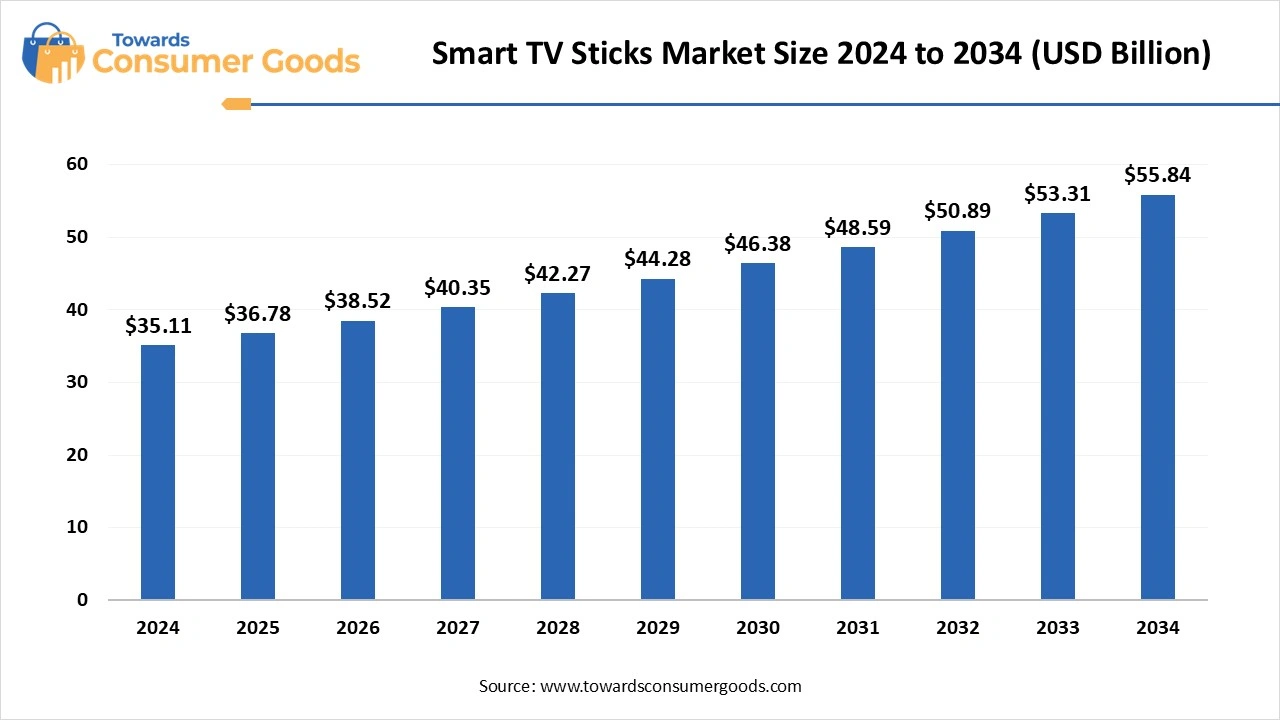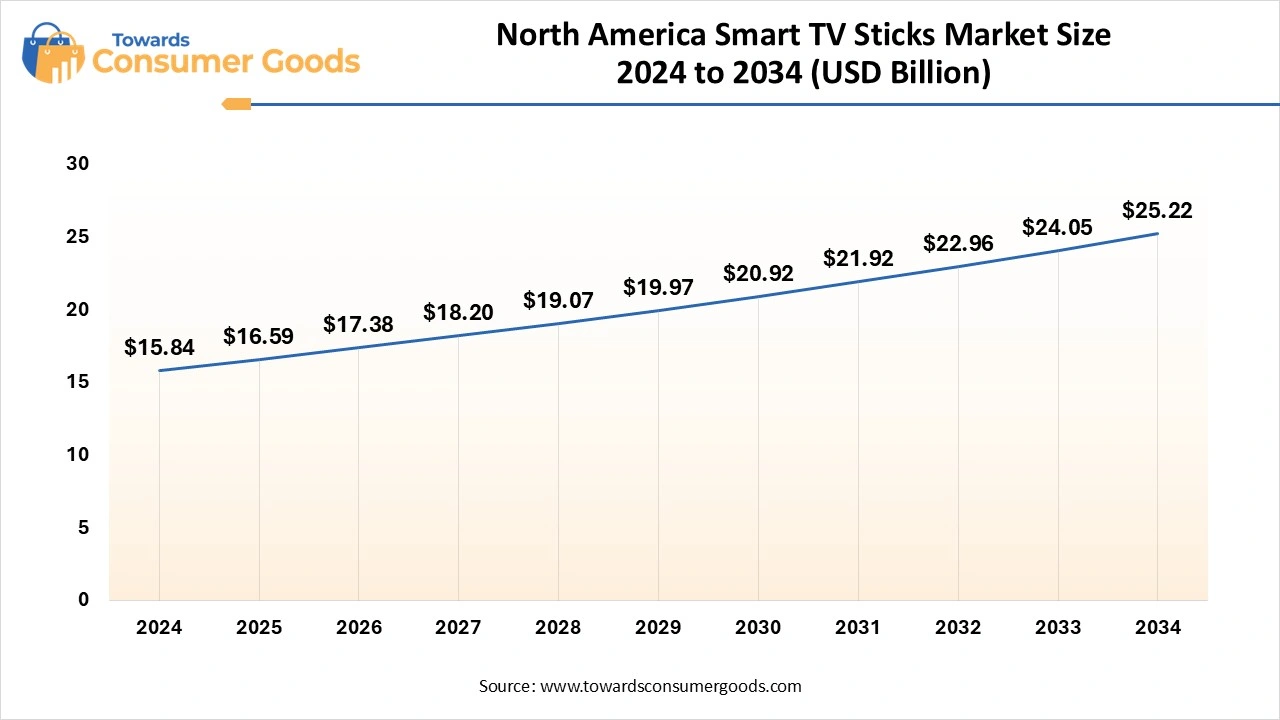June 2025
The global smart TV sticks market was calculated at USD 35.11 billion in 2024 and is projected to reach around USD 55.84 billion by 2034, with a CAGR of 4.75%. The consumer shift towards streaming solutions due to their affordable prices and growth in OTT content has driven the market demand.

OTT Platforms and Easy Access to Streaming Apps Drive the Market
The smart TV sticks market is flourishing, driven by an insatiable appetite for budget-friendly and hassle-free streaming solutions. This surge is largely fueled by the soaring popularity of online streaming platforms, which have become essential in today’s media landscape. Key drivers of this growth include the burgeoning smart home ecosystems, where devices seamlessly connect and interact to enhance daily living, the persistent demand for streaming apps that are easily accessible, and the growing movement towards cable-cutting lifestyles.
As beloved services like Netflix, Amazon Prime, and Hulu captivate audiences worldwide, the need for devices that effortlessly tap into these rich libraries of content has never been greater. Smart TV sticks are at the forefront of this trend, integrating beautifully into larger smart home systems alongside voice assistants and other interconnected devices, thereby elevating user experience and convenience to new heights. The increased availability of high-speed internet has further democratized streaming access, making it more appealing and widespread, which in turn drives the demand for these sleek little devices.
These sticks empower users to enjoy content wherever they are, catering to the increasing desire for mobile and on-the-go consumption. They symbolize a liberating shift away from traditional cable subscriptions, reshaping the way people engage with media. However, as more devices become internet-connected, the industry faces growing privacy and security challenges that must be adeptly addressed by manufacturers. Within this thriving market, the demand for affordable streaming solutions continues to surge, propelled by rising internet penetration and the widespread appeal of over-the-top (OTT) content.
Smart TV sticks have emerged as a compelling alternative for consumers eager to alleviate the financial burden of cable TV, offering a versatile and economical pathway to an extensive array of streaming services. The prevalence of high-speed internet in households only intensifies the need for these versatile devices, as the popularity of platforms like Netflix and Amazon Prime fuels their adoption.
Consumers are increasingly inclined towards smart devices that offer seamless integration within their homes, and this trend is providing fertile ground for the expansion of the smart TV sticks market. The ability to effortlessly stream content from mobile devices to larger displays via these sticks is a feature that resonates deeply with users, further propelling market growth. Renowned for their straightforward setup and intuitive interfaces, smart TV sticks have become a favorite among consumers of all ages and technical backgrounds.
The competition in this landscape is fierce, as numerous brands vie for attention with similar offerings. In such a saturated market, standing out through unique features, user-centric designs, and compelling marketing is paramount. To keep pace with rapidly shifting consumer preferences and technological advancements, continuous innovation in features, functionality, and overall user experience is essential.
| Report Attributes | Details |
| Market Size in 2025 | USD 36.78 Billion |
| Expected Size by 2034 | USD 55.84 Billion |
| Growth Rate | CAGR of 4.75% |
| Base Year in Estimation | 2024 |
| Forecast Period | 2025-2034 |
| Dominant Region | North America |
| Segment Covered | By Distribution Channel, By Region |
| Key Companies Profiled | Roku, Sky Group, ASUS, Shenzhen Rikomagic Tech, Dongguan Sonicway Electrical Appliance, Shenzhen Tomato Technology, CloudWalker Streaming Technologies, Amazon, Apple Inc., Google |
Preference in Streaming Services
The potential for growth within the smart TV sticks market remains vast, spurred on by the accelerating demand for streaming services and the proliferation of smart home environments. Factors like enhanced internet access, the allure of economical streaming options, and a growing inclination toward consuming content on the go all contribute to this rapid market expansion. As more individuals choose streaming over traditional cable, the need for smart TV sticks powerful devices that unlock access to a myriad of applications and services is intensifying.
These sticks are integral to modern smart home setups, allowing users to manage their entertainment while connecting seamlessly with other smart devices. With growing availability and affordability of internet access, the appetite for streaming solutions will only grow, further igniting the market for smart TV sticks. This burgeoning sector welcomes a diverse array of users, from households and businesses needing entertainment solutions for hotels and offices to educational institutions pursuing virtual learning, as well as gamers seeking cloud gaming experiences.
Emerging markets with increasing internet penetration represent significant untapped growth potential for smart TV sticks, with enticing features like 4K streaming and artificial intelligence (AI)-enhanced recommendations paving the way for a vibrant future.
Cost of the Product
The smart TV sticks market encounters a myriad of challenges that significantly influence its trajectory, including affordability, content fragmentation, compatibility hurdles, and the relentless demand for innovation. These obstacles not only hinder market penetration but also shape the overall user experience and growth dynamics. While smart TV sticks are often positioned at a relatively low price point, this cost can still serve as a considerable barrier for lower-income consumers, particularly in regions where disposable income is limited.
The explosion of diverse OTT platforms, each offering exclusive content, adds to the complexity as users find themselves compelled to juggle multiple subscriptions in their quest for desired entertainment, thereby diminishing the perceived value of smart TV sticks. Moreover, the landscape of smart TVs is dotted with specific operating systems, creating compatibility challenges with certain streaming devices or applications, which can severely restrict user engagement.
The ever-evolving nature of these operating systems and the necessity to support legacy TV hardware introduce additional complications for Connected TV apps. The quest for a seamless and user-friendly experience across diverse platforms and devices remains paramount, demanding meticulous design and thoughtful development.
The electronics stores segment led in the smart TV sticks market in 2024. They offer a tactile shopping experience, expert guidance, and personalized recommendations all of which resonate strongly with consumers. For those who cherish the ability to physically interact with a product before making a purchase, electronics stores provide an irreplaceable advantage. Knowledgeable staff members are on hand to elucidate the myriad features and advantages of various smart TV sticks, empowering customers to make informed choices. Personalized recommendations tailored to individual preferences enhance the shopping journey, setting electronics stores apart from the convenience of online platforms, which, while beneficial in many ways, lack the immersive, interactive essence of in-person shopping.
The online segment expects the fastest growth in the market during the forecast period. The segment witnessing the most rapid growth in the smart TV sticks market. This surge is driven by a confluence of factors namely, increased internet access in previously underserved regions, the meteoric rise of OTT platforms, and a cultural shift towards consuming content on the go. As internet penetration and speeds improve globally, particularly in areas that once lagged in digital infrastructure, streaming services become not just accessible but also appealing.
Budget-friendly data plans further fuel this trend, leading to a robust increase in OTT platform viewership. Smart TV sticks emerge as a cost-effective solution for those longing to elevate their viewing experience without the financial burden of purchasing a new smart TV. This option is especially enticing for consumers who wish to transition from enjoying content on their phones or tablets to relishing it on a larger screen. The sweeping digital transformation occurring across various nations also catalyzes the burgeoning demand in the smart TV streaming device market.
North America dominated the market in 2024. In the vibrant panorama of the smart TV sticks market, North America, particularly the United States, stands at the forefront, shaped by an array of pivotal factors. A robust consumer electronics market, extensive internet penetration, and a tech-savvy populace all converge to fuel the demand for smart TV sticks.
The North America smart TV sticks market size was valued at USD 15.84 billion in 2024 and is expected to be worth around USD 25.22 billion by 2034, growing at a compound annual growth rate (CAGR) of 4.76% over the forecast period 2025 to 2034.

The United States boasts a rich legacy as a major player in the consumer electronics sector, creating fertile ground for innovative technologies like smart TV sticks. With a significant portion of the population enjoying access to high-speed internet, seamless streaming of content becomes a reality, enhancing the appeal of these devices. North Americans are quick to embrace new technologies, especially those that amplify their entertainment experiences. The advanced digital infrastructure in North America, characterized by widespread broadband and cutting-edge 5G technology, serves as a strong foundation for the flourishing market.

Asia-Pacific expects fastest growth in the smart TV sticks market during the forecast period, spurred by a blend of factors such as rising disposable incomes, escalating internet connectivity, and an increasing inclination toward streaming services. Enhanced spending power across many Asia-Pacific nations empowers consumers to invest in home entertainment and smart home technologies, ushering in a new era of viewing pleasure.
Innovation- In May 2025, Xiaomi launched 4K FX and QLED FX Pro and series smart TVs in India with designed in Fire TV.
Innovation- In February 2025, Reliance Jio launched JioTele OS for affordable price smart TVs in India.
Innovation- In April 2025, Startup Lumio vowed to fix India’s ‘slow TV epidemic’ with its Vision 7 and Vision 9 series, and the price starts from ₹29,999.

June 2025
June 2025
June 2025
May 2025